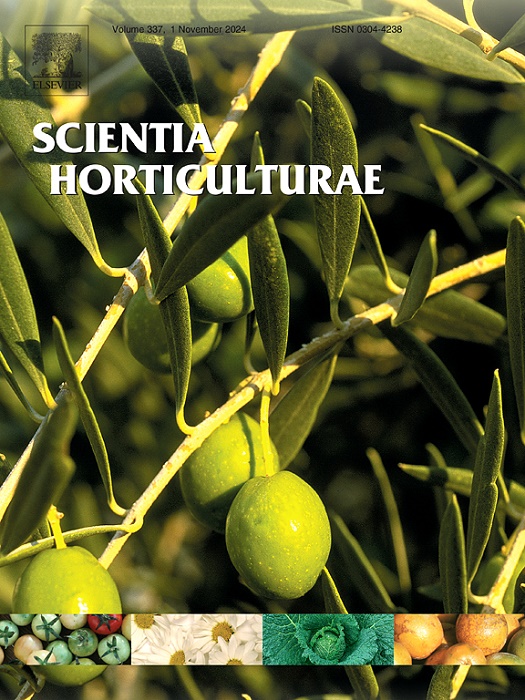代谢组学和转录组学揭示了与甘薯顶端苦味和涩味相关的代谢物和基因
IF 3.9
2区 农林科学
Q1 HORTICULTURE
引用次数: 0
摘要
甘薯嫩梢是一种具有特殊风味和高营养价值的潜在蔬菜,但只有叶用型甘薯嫩梢受到消费者的欢迎,而大多数类型的甘薯嫩梢因其苦涩味而未被广泛接受为蔬菜。在此,为了揭示甘薯嫩梢苦涩味化合物形成的生物途径,我们对三个苦涩味程度不同的甘薯品种进行了代谢组学和转录组学研究。代谢组学分析表明,139 种代谢物可能与甘薯嫩梢的苦味和涩味有关,其中 31 种黄酮苷和羟基肉桂酸衍生物可能协同影响苦味和涩味。组氨酸、生物碱和萜类化合物专门决定苦味,而黄酮醇/黄酮苷和七种酚酸衍生物专门影响涩味。转录组分析确定了负责苦味和涩味化合物积累的 46 个结构基因和 24 个转录因子,然后利用它们构建了生物合成途径。两个 bHLH 被确定为苦味生物合成途径中的枢纽基因,四个 MYB 和一个 bHLH 是苦味和涩味生物合成途径中的共同转录因子。该研究为了解甘薯新梢苦味和涩味的形成机制提供了有价值的信息,也为叶用型甘薯的改良提供了重要信息。本文章由计算机程序翻译,如有差异,请以英文原文为准。
Metabolomics and transcriptomics reveal metabolites and genes associated with the bitterness and astringency in sweet potato tips
Sweet potato tips are a potential vegetable with special flavor and high nutrients, but only the leafy type is popular among consumers, while most types of sweet potato tips are not widely accepted as a vegetable due to their bitter and astringent taste. Here, to reveal the biological pathway involved in the formation of bitter and astringent compounds in sweet potato tips, metabolomics and transcriptomics were performed for three sweet potato varieties with different levels of bitterness and astringency. Metabolomics analysis revealed that 139 metabolites might be related to both bitterness and astringency of sweet potato tips, and 31 flavonoid glycosides and hydroxycinnamic acid derivatives may synergistically affect bitterness and astringency. Histidine, alkaloids, and terpenoids specifically determine bitterness, while flavonol/flavone glycosides and seven phenolic acid derivatives specifically affect astringency. Transcriptome analysis identified 46 structural genes and 24 transcription factors responsible for the accumulation of bitter and astringent compounds, which were then used to construct the biosynthetic pathways. Two bHLHs were identified as hub genes in biosynthetic pathways of bitterness, and four MYBs and one bHLH were common transcription factors in the biosynthetic pathways of both bitterness and astringency. This study provides valuable insights into the formation mechanisms of bitter and astringent taste in sweet potato tips and important information for improvement of leafy type sweet potato.
求助全文
通过发布文献求助,成功后即可免费获取论文全文。
去求助
来源期刊

Scientia Horticulturae
农林科学-园艺
CiteScore
8.60
自引率
4.70%
发文量
796
审稿时长
47 days
期刊介绍:
Scientia Horticulturae is an international journal publishing research related to horticultural crops. Articles in the journal deal with open or protected production of vegetables, fruits, edible fungi and ornamentals under temperate, subtropical and tropical conditions. Papers in related areas (biochemistry, micropropagation, soil science, plant breeding, plant physiology, phytopathology, etc.) are considered, if they contain information of direct significance to horticulture. Papers on the technical aspects of horticulture (engineering, crop processing, storage, transport etc.) are accepted for publication only if they relate directly to the living product. In the case of plantation crops, those yielding a product that may be used fresh (e.g. tropical vegetables, citrus, bananas, and other fruits) will be considered, while those papers describing the processing of the product (e.g. rubber, tobacco, and quinine) will not. The scope of the journal includes all horticultural crops but does not include speciality crops such as, medicinal crops or forestry crops, such as bamboo. Basic molecular studies without any direct application in horticulture will not be considered for this journal.
 求助内容:
求助内容: 应助结果提醒方式:
应助结果提醒方式:


